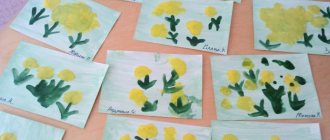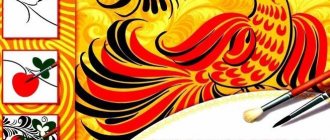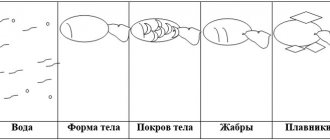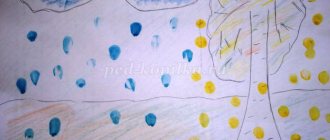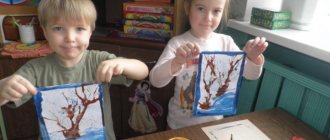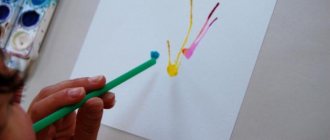Lesson 41. Drawing “The little Christmas tree is cold in winter”
Program content.
Teach children to convey a simple plot in a drawing, highlighting the main thing. Learn to draw a Christmas tree with branches elongated at the bottom. Strengthen the ability to draw with paints. Develop figurative perception, figurative ideas; the desire to create a beautiful drawing and give it an emotional assessment.
Methodology of conducting the lesson.
Remember the song about the Christmas tree with the children. Offer to show the direction of the trunk and branches with your hands in the air. Call one of the guys to the board to draw a Christmas tree. Specify the color of the young Christmas tree. While working, remind the children that they need to draw a small Christmas tree among the large Christmas trees and trees.
Look at the finished drawings and enjoy their diversity with the children.
Materials.
Sheets of white paper, gouache paints dark green, light green and dark brown; brushes, a jar of water, a napkin (for each child).
Connections with other activities and activities.
Singing songs about the Christmas tree in music classes.
Lesson 42. Modeling “Bird”
Program content.
Teach children to sculpt a bird out of clay, conveying the oval shape of the body; pull back and pinch small parts: beak, tail, wings. Learn to celebrate the diversity of the resulting images and enjoy them.
Methodology of conducting the lesson.
Remember with the children how they watched the birds on a walk. Consider a toy bird. Clarify the parts of the bird's body and their shape. Ask children about modeling techniques. Encourage students to use a variety of techniques while working.
In conclusion, consider all the birds, suggest choosing the most beautiful ones, different in size, and tell about them.
Materials.
Toy bird. Clay, modeling board, stack (for each child).
Connections with other activities and activities.
Bird watching on a walk, in a corner of nature. Examination of illustrations, ceramics, folk toys.
Lesson 43. Application “Beautiful pyramids were brought to the store”
Program content.
Exercise children in cutting out rounded shapes from squares (rectangles) by smoothly rounding the corners. Reinforce scissor handling techniques. Learn to select colors and develop color perception. Learn to arrange circles from largest to smallest.
Methodology of conducting classes.
Invite the children to cut out a pyramid. Learn the techniques for cutting out round shapes. Say that children can choose colors in their own way. Remind about accuracy in work, the need to correctly position parts of the image (from the largest circle to the smallest), and place it beautifully on a sheet of paper.
Review all completed work. Note how many beautiful pyramids the guys made.
Materials.
Paper squares of different colors and sizes, sheets of paper the size of 1/2 landscape sheet, scissors, glue, glue brush, napkin (for each child). Semicircular stand.
Connections with other activities and activities.
Games with toys (with specification of their shape, size, color). Classes on the formation of elementary mathematical concepts (an exercise in arranging figures by size in decreasing order).
Lesson 44. Drawing “Spreading tree”
Program content.
Teach children to use different pressure on a pencil to draw a tree with thick and thin branches. Cultivate the desire to achieve good results. Develop imaginative perception, imagination, creativity.
Methodology for conducting the lesson
. Remember with the children what trees they saw on a walk, what branches they had. Show how, by pressing the pencil in different ways, you can draw thin and thick branches.
While drawing, try to regulate the pressure on the pencil.
Please review all finished drawings. Mark the most expressive ones (those that convey the difference between thin and thick branches, a spreading crown).
Materials.
Paper 1/2 landscape size, 3M graphite pencils (for each child).
Connections with other activities and activities.
Observations on walks, looking at illustrations.
Lesson 45. Modeling “Make whatever toy animal you want”
Program content
. Teach children to independently determine the content of their work. Strengthen the ability to sculpt using different sculpting techniques. Foster independence and activity. Develop imagination and the ability to talk about the created image.
Methodology of conducting the lesson.
Talk with children about familiar animals (fish, birds, etc.).
Consider with your children pre-selected toys depicting animals (hare (rabbit), puppy, mouse, kitten, etc.). Ask the guys what shape the main parts of the animal’s body and other parts are (head, neck, paws, ears, tail).
Invite the children to sculpt whatever animal they want. Offer to show with your hands in the air how they will sculpt the animal.
During the lesson, direct the children’s attention to a more accurate representation of the shape and size of the parts. At the end of the work, look at all the images and enjoy their diversity.
Materials
. Toy animals. Clay (plasticine, plastic mass), modeling board, stack (for each child).
Connections with other activities and activities.
Reading books, learning poems, looking at illustrations, didactic games (“Which toy is missing”, etc.), games in the play corner.
Lesson 46. Application “Bus”
Program content.
Strengthen children's ability to cut out the necessary parts to create an image of an object (object). Strengthen the ability to cut off the corners of a rectangle, rounding them (bus body), cut the strip into identical rectangles (bus windows). Develop the ability to formulate your idea compositionally.
Methodology of conducting the lesson.
Remind the children that they saw buses on walks and excursions on the streets of the city (village). Ask about the shape of the main parts and smaller parts of the bus; specify from which paper blank what needs to be cut out (pay attention to each detail prepared for the applique).
Clarify cutting techniques and rounding corners of a rectangle to create a bus body. Call to the board to show a child who has mastered the technique of rounding corners. Remind you that you need to think in advance about how to place all the parts of the bus on a piece of paper so that the bus turns out beautiful. Ensure proper use of scissors and careful handling of paper and glue.
Those children who quickly make the applique are offered to decorate the bus.
Put all the finished works on the board, talk about how there are a lot of buses, they are all beautiful and bright.
Materials.
Colored rectangular paper 10x4 cm for the bus body, strips of blue paper 2x8 cm for windows, 2 black squares 2.5x2.5 cm for wheels, scissors, glue, glue brush, strips of paper of different colors (from which children will cut parts) (for each child).
Connections with other activities and activities.
Games with toy cars, buses. Observations on the street of transport. Reading literature on the topic, looking at illustrations.
Option. Application “Trolley with toys (balls, bricks, cubes)”
Program content.
Teach children to use scissors: hold them correctly, cut paper in a straight line, round the corners of a square to get a circle. Learn to compose an image from parts, correctly positioning and carefully gluing them. Develop initiative.
Methodology of conducting the lesson.
Show the children a toy cart with bricks, clarify the shape of the toy parts, and paper cutting techniques. Ask the children which of them wants to show the circle cutting techniques at the board.
Offer to cut and paste the cart, and then the load it is carrying. Approach each child and ask what load will be on his cart. Encourage interesting additions.
Materials.
Colored paper, scissors, glue, glue brush, napkin (for each child).
Connections with other activities and activities.
Children play with toys, clarify ideas about their shape, color, size.
Lesson 47. Modeling “Girl in a long fur coat”
Program content.
Teach children to depict a human figure in sculpting, observing the ratio of parts in size. Strengthen the ability to roll clay between your palms; sculpt with your fingers, give the figure the desired shape; connect the parts, pressing them tightly against each other, and smooth out the fastening points.
Methodology of conducting the lesson.
Examine with the children a doll in a long fur coat, determine what parts it consists of, what size and shape they are. Clarify modeling techniques by asking the children and showing them with your hands in the air. Remind children that they can mark the buttons on a fur coat and decorate the fur coat. During the work, remind about the relationship of parts and modeling techniques (as necessary).
At the end of the lesson, look at all the dolls, note the variety and imagery of the figures.
Materials.
A doll in a long fur coat, a small sculpture. Clay, modeling board, stack (for each child).
Connections with other activities and activities.
While walking, while playing with dolls, clarify the proportions of the human figure. Examination of the image of a human figure in illustrations, photographs, pictures.
Lesson 48. Drawing “Draw whatever toy you want”
Program content.
To develop children’s ability to conceive the content of a drawing, create an image, conveying the shape of the parts. Strengthen painting skills with paints. Learn to look at pictures, choose the ones you like, and explain what you like. Foster independence. Develop creativity, imagination, and the ability to talk about the created image. Form a positive emotional attitude towards the created drawings.
Methodology of conducting the lesson.
Invite the children to name their favorite toys, ask who wants to draw which toy; pay attention to the shape of the main part of the toy, the shape of other parts and details. Ask how you can draw toys. If necessary, help with advice and showing toys.
Review all completed work. Note the variety of images created. Induce a positive emotional attitude towards the drawings.
Materials.
Landscape sheets, gouache paints, brushes, jars of water, napkins (for each child).
Connections with other activities and activities.
Playing with toys, clarifying their shape. Didactic games aimed at mastering the shape, size, structure of objects.
Lesson 49. Decorative drawing “Decoration of a handkerchief” (Based on Dymkovo paintings)
Program content.
Introduce children to the painting of the Dymkovo toy (young lady), teach them to highlight the elements of the pattern (straight lines, intersecting lines, dots and strokes). Learn to cover the sheet evenly, with continuous lines (vertical and horizontal), and place strokes, dots and other elements in the resulting cells. Develop a sense of rhythm, composition, color.
Methodology of conducting the lesson.
With your children, examine the pattern that decorates the skirts of young ladies (it is better to take a checkered pattern), highlight the elements of which it consists; their location. Offer to draw the same one. Together with the children, draw a pattern on a piece of paper pinned to the board, then allow the children to draw on their own pieces of paper.
Materials.
Dymkovo ladies. Gouache paints (for different tables in different colors), square sheets of paper 18x18 cm, brushes, jars of water, napkins (for each child).
Connections with other activities and activities.
Getting to know Dymkovo toys. Expanding ideas about the richness and variety of toys and their decoration. Looking at beautiful handkerchiefs and their decorations.
Lesson 50. Modeling according to plan
Program content.
Strengthen children’s ability to conceive the content of their work, using learned methods of creating an image, and bring their plans to the end. Foster independence, activity, creativity. Create a desire to admire your works and talk about them.
Methodology of conducting the lesson.
Invite the children to sculpt whatever they want. Ask several guys what they came up with and how they will implement their plans.
During the sculpting process, monitor the children’s actions and, if necessary, help with advice, showing some techniques on a separate lump of clay.
At the end of the lesson, review all the works, offer to choose the most interesting ones, explain your choice; Invite the children who sculpted them to talk about their work.
Materials.
Clay, modeling board, stack (for each child).
Connections with other activities and activities.
Children playing with toys, observing on walks and excursions, reading books, singing songs in music classes. Acquaintance with a variety of folk toys.
Lesson notes on art
This section is devoted to the visual activities of preschoolers.
In the column on the left side there are links to ready-made notes for drawing classes, modeling classes, classes for designing from paper, natural materials and other types of art. activities. Some of the activities combine drawing, modeling, applique, speech development, familiarization with nature and the surrounding world. You can download any of the notes in one file. It should be remembered that quite a lot of classes in other categories also contain elements of visual activity (almost all complex classes and many of the classes in the “familiarization with nature” section - almost all classes for familiarization with plants and animals include modeling, drawing, appliqué, design made from natural material or paper), therefore, if you don’t find the activity you need here, you can look for it in other sections of our website. We hope that these notes will help you in working with children in kindergarten.
Modeling, drawing and any type of construction from paper or natural material are a powerful tool for influencing the development of children in the hands of a competent teacher. It is known that a child learns material best if he is interested in the object of study itself, and making drawing or modeling interesting is not so difficult. In addition to experience working with paints, plasticine or natural materials, children gain knowledge about the world around them and develop fine motor skills of their fingers, which has a beneficial effect on the development of speech. That is why art classes often become the basis for complex or integrated classes with elements of familiarization with nature, speech development and familiarization of children with the world around them.
In addition, drawing and other types of visual activities help develop children’s imagination and imagination, and also teach them to be neat, diligent and persevering. Well-designed stands with exhibitions of children's works delight parents of children and allow children to feel their importance.
If you notice any inaccuracies or omissions, please let us know. Also, if you have your own classes, then share them with others, write to us, send us the material and we will add to the number of notes.
Integrated lesson in the middle group “Frosty patterns”
Summary of an open integrated lesson in the middle group “Frosty patterns”
Educator
MBDOU – d/s No. 18 “Cinderella”
E.S. Zinoviev
Tasks
:
Educational:
Learn to depict winter patterns using an unconventional drawing method - nitography.
To consolidate children's knowledge about the season - winter; about its characteristic features; about winter fun and entertainment.
Activate children's vocabulary using adjectives to describe the winter season: snowy, frosty, cold.
Educational:
Arouse children's interest in the drawing process. Develop aesthetic perception and the ability to use gouache.
Educational:
To cultivate attention, accuracy and interest in visual arts, the desire to complete the work started, responsiveness, and the desire to help Santa Claus.
Integration of educational areas
Educational field “cognitive development”:
consolidation of knowledge about winter natural phenomena, winter clothing and winter entertainment.
Educational area “speech development”: consolidation of adjectives about winter - snowy, cold, frosty, white.
Educational field “artistic and aesthetic development” - to provide knowledge about the innovative method of drawing - nitkografiya; develop an aesthetic perception of beauty, the use of musical accompaniment, etc.
Educational field “social and communicative development”: the ability to work in a team, not interrupt each other when answering questions.
Educational area “physical development”: compliance with hygienic requirements for the lesson, use of a dynamic pause in the middle of the lesson, changing body positions during the lesson: sitting, standing, moving around the room.
Equipment:
Dudu Monkey Costume;
Multimedia projector, slides by season - summer, winter; Subject pictures “Clothing”;
A flat cardboard house with windows, sheets of blue cardboard and woolen threads according to the number of children, white gouache, paint plates, wet wipes, thermal wipes.
Musical accompaniment: melody from the film “Chunga-changa”, musical game with acceleration “Making a Snowman”, work “Winter” by P.I. Tchaikovsky;
Progress of the lesson:
The group teacher leads the children to the place where the lesson is held, where they are met by the monkey Dudu.
(Turn on the music!)
The melody from the film “Chunga-Changa” is playing.
Monkey Dudu:
Hello guys! My name is monkey DUDU. I flew by plane from Africa to my friends: a bunny, a fox, a wolf cub, a bear cub and a squirrel. Would you like me to introduce you to them?
Let's sit down on the chairs, and I will show you a photo of my friends (the children sit on the chairs in a semicircle, and the teacher (DUDU the monkey) is in front of the projector.
Look, here are my friends. Do you recognize them? Who is shown in the photograph? (Children name animals) (Slide 1).
What time of year do you see in the picture? (Children's answers: summer) Why did you decide that? (The picture shows green grass, flowers all around, and the bright sun is shining).
That's right, well done guys!
Ask children individually: Do you agree with...? Do you think so too?
In my homeland, in Africa, it is always warm, the sun shines, and bananas grow and there is never snow. (Slide 2)
Guys, I don’t know what winter is.
With you, everything is different. Everything on the street is white, something crunches underfoot. Why do you think? Children answer: It’s winter outside. Who can tell me about winter? (Slide 3)
What is winter like? (cold, snowy, frosty, everything around becomes white, ice appears on the rivers, frost turns silver on the trees, white fluffy snow falls).
If children find it difficult, ask guiding questions:
Why is winter white? (There is white snow all around).
Why can we say about winter that it is snowy? (Because there is a lot of snow).
If it's cold outside, what
winter? (Cold winter).
Who thinks differently? Do you... think the same?
And if it’s frosty outside, what
winter? - frosty.
Individually ask the children to repeat all the adjectives named.
Now I understand that winter can be cold, frosty, with snow and ice. BRRRR, it's cold in winter. When I arrived from Africa, I was so cold because I didn’t have winter clothes. Do you have winter clothes? Tell me, what do you wear when you go out? (Answer options: fur coat, hat, down jacket, warm pants, mittens, scarf, felt boots).
So much clothing to keep warm in winter!
What are mittens for? What is the hat for?
What should you wear to prevent your feet from getting cold?
There are so many different clothes that I got confused. Can you help me figure it out?
On the table there are pictures of summer and winter clothes mixed together.
Monkey Dudu:
Here are two magnetic boards: on one there is a summer picture, and on the other there is a winter picture. Guys, there are summer and winter clothes on the table here.
Help me take it apart...
Tell me, where should I place this cap? (On a magnetic board with “winter”).
Do you...agree?
Who thinks differently?
Where should I place my hat? (On a magnetic board with a summer picture).
Okay, now try it yourself, just in a friendly manner, together, don’t push and don’t quarrel.
Summarize:
Guys, have you noticed that there are more winter clothes than summer ones?
Why do you think? (In winter you need to dress warmer, so there is a lot of clothes)
Monkey
Dudu :
No, guys, it’s still not interesting in winter. It’s fun in our jungle: you can play, jump from tree to tree. And it's cold here in winter.
You guys are probably sitting at home, warming up in your apartments and not going out at all? (Children's answers - we're walking)
What can you do during a walk in winter, what games can you play?
(Children's answers: sledding, downhill on ice, skiing, ice skating).
Wow, I will definitely learn to play all these games (Slide 5).
Look, haven’t you forgotten anything, haven’t you missed anything?
Monkey Dudu
:
Oh, what are these guys doing, rolling around some lumps? (Children's answers: they are making a snowman.)
Let's build a snowman together to fun music? (get up, teach me how to play winter games)
(Turn on the music!)
Physical education (with acceleration, 3 times).
Monkey Dudu:
Draws children's attention to the exhibition of frosty patterns.
I wonder who painted such beautiful pictures? (suitable for the exhibition of paintings “Frosty Patterns”)
Children's answers: (Grandfather Frost) Who is this and what does he look like?
(Children answer: he is a good wizard, he gives gifts, he has a beard, mittens, etc.)
Guys, I know who it is, I saw him, listen:
The old man doesn't sleep all night; he has a job. He sits under the tree and draws something. He takes a magic brush and paints in his hands, And he draws different drawings on the windows, He must paint all the windows in the houses by morning, So that all the children can see this beauty.
Monkey
Dudu
: Yes, beautiful patterns, what do they look like? (Patterns look like herringbone, twigs, snowflakes, curls and even palm trees)
...what do you see? Give children the opportunity to imagine.
These are the beautiful patterns Santa Claus drew!
Monkey
Dudu
Guys, look. Here is a house, but its windows are not painted.
I wonder if you can draw such patterns yourself and help Santa Claus?
It must be difficult for him to paint so many windows?
Of course you can try.
What do you usually draw with? (paints, brushes, felt-tip pens, pencils)
Monkey
Dudu
And I love to draw with his tail! Do you have tails?
Ask the children individually if they have tails.
What will you paint with? Idea! I have woolen threads. Look, do they look like my ponytail?
Now I will show you how to draw with a thread.
Demonstration of nitcography technique.
I take a long thread and dip it in white
Gouache not completely, so as not to get dirty. And I start drawing for her, like this, look.
You can roll it into a ring - like this, or you can draw straight lines with the tip of a thread, you can make wavy lines, you can make dots that look like a snowball, you can draw a Christmas tree or a twig by twisting the thread into a loop and pulling it to the side. Look how beautiful it turns out. This method of drawing is called threadography - drawing with a thread.
Let's say in unison -
nitkografiya.
Individual repetitions for children.
Now, everyone, sit down at the tables and try it yourself. We will try very hard to make it beautiful, and for this you need to sit up straight and keep your back straight.
Get to work, guys. (turn on music )
The music “Seasons” sounds. Winter" P.I. Tchaikovsky
During the drawing process, the teacher helps the children.
Finish your work, guys, don’t forget to put the threads on a plate so as not to stain the tables; if you get your hands dirty, wipe them with a damp cloth. In the meantime, while our windows are drying out, come to me.
Monkey
Dudu
: gathers all the children in a circle.
Thank you guys for telling me everything about winter. Now I know a lot about this time of year. Remind me what kind of winter it is? (Answers) Wonderful!
Now I will also dress warmly: I will put on a hat and felt boots and... I forgot, tell me what else is needed? And the games and fun you have are so interesting! What are they called? I will definitely play winter games.
Guys, what a great job you are, you helped Santa Claus paint the windows!
Did you like my way of drawing with a ponytail?
What is it called? Who remembered? – nitcography. Right!
Now take your windows and go to the house. Let's put our windows there. What a beautiful house it turned out to be. Santa Claus will really like your patterns on the windows.
Praise and celebrate each child. (Vanya painted this window, and this is Nastya, etc.)
Monkey
Dudu:
And I want to give you this banana as a souvenir of our meeting. But it is not simple, but with a surprise. What do you think is inside?
My favorite is banana candy.
I really liked your place, but I have a plane soon and it’s time for me to return home to my Africa. But I still have time to take you to the group.
Monkey Dudu accompanies the children to the group.
Goodbye, guys!
ISO. Lesson notes for fine arts in kindergarten
The useful materials in this section will help you intelligently and competently, step by step, organize creative arts classes with children. Whether it’s drawing, modeling, designing or appliqué, each such mini-event requires proper organization and a thoughtful, conscious approach.
Here you can find ready-made notes for classes on joint creativity with children of any age. Many of them are illustrated with original photographs taken by the authors “as the action progresses.” On the pages of the section there are a great many truly successful activities, the results of which I would like to share with colleagues.
For you - an inexhaustible source of inspiration for positive children's creativity.
Showing publications 1-10 of 22061. All sections | ISO. Lesson notes for fine arts in kindergarten
Summary of the conversation in the senior group "Military equipment - a protector and assistant to soldiers" Synopsis of a conversation in a senior group on the topic: "Military equipment - a protector and assistant to soldiers"
Goal: Education of moral and patriotic feelings, love for the Motherland, respect for the Russian army. Program objectives: - Expand children's understanding of the Russian army and military equipment.
Summary of educational activities on drawing “Round Dance of Matryoshka Dolls” in the middle group
Notes on drawing “Round Dance of Matryoshka Dolls”
1) Theme of GCD (
classes - “Round Dance of Matryoshka Dolls”
2) Age group - Middle group 3) Educational area - artistic and aesthetic development. 4) Objectives: 1. Educational: Continue to introduce children to the folk toy matryoshka.

